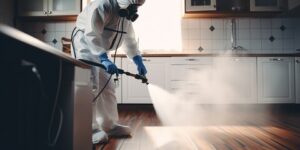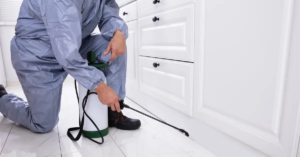Pests cause property damage and pose a risk to human health. They can carry diseases such as hantavirus, leptospirosis, and Salmonella. They can also cause damage to plants. A professional pest control expert can help you eliminate them quickly and safely.
Physical methods include cleaning up debris, sealing cracks, and repairing windows and doors. Trimming trees and bushes removes places for pests to hide. Contact Pest Control Augusta Maine now!

Pest control is a necessary part of keeping your home and yard safe. However, the cost of these services can vary widely depending on where you live and the type of pest infestation you have. In addition, prices can also vary by company. Those with longer service histories are likely to charge more, while newer companies may offer lower rates. In order to make sure you’re paying the right price, it’s important to understand the average pest control cost in your region.
A basic pest control session is typically priced between $50-$75, but this amount can quickly climb based on the kind of pest and the severity of damage. In some cases, the cost can even exceed thousands of dollars. To help you avoid expensive surprises, be sure to get quotes from several companies before deciding on one.
There are many different ways to perform a pest control treatment, including baiting, spraying, fumigation, or a combination of techniques. Some pests, such as mice, require repeated treatments because of their high reproduction rate. Others, such as cockroaches and fleas, can be eliminated with one treatment. You should always ask the company how they plan to treat the pests and whether they have a guarantee for their work.
The cost of pest control is largely dependent on the labor and materials used. The more labor and chemicals required, the higher the cost will be. It’s also important to consider the additional costs of equipment, such as protective gear and tools.
Most pest control companies provide a variety of services, from preventive treatments to eradication. They can treat both indoor and outdoor spaces, as well as perform inspections of the property. They can also remove wildlife, such as raccoons and squirrels. This process may include humane trapping and transporting them to a safe location.
While pests may be annoying, they don’t necessarily cause significant harm to humans or animals. In fact, some species of pests are beneficial to the environment. The goal of pest control is to reduce the number of unwanted species and minimize their damage. This can be done by prevention – keeping pests from entering the area; suppression – reducing the number of pests to an acceptable level; or eradication – killing the pests and removing their habitat.
Qualifications
Having the right qualifications is crucial for pest control services. Exterminators are required to have a license to work with pesticides, which are often dangerous chemicals that can cause serious injury or even death if they are misused. They must complete a course and pass a certification exam to become a licensed pesticide applicator. The training program must be approved by the state and offer practical knowledge of how to safely use the chemicals. Some states also require pesticide applicators to have workers’ compensation insurance.
A high school diploma is the minimum requirement for this profession, but a college degree is preferred. Most pest controllers start their career as technicians, receiving formal classroom and on-the-job training to learn about pesticide safety and use. They are then trained in one or more pest control categories, such as nuisance pests (such as ants, termites, and mosquitoes), wood preservation and treatment, fumigation, and ornamental and turf pests.
In addition to being licensed, pest control technicians should be in good physical condition and comfortable working alone. They should also be able to follow written and oral instructions, as mistakes in applying or handling chemicals can lead to injury or death. In some cases, pest control technicians are required to wear a mask and protective clothing when handling hazardous materials.
While a business owner may be tempted to cut corners by hiring less-qualified employees, it’s important to choose a qualified and certified pest control technician for any service. This is especially true for commercial properties, such as office buildings, hospitality locations, and healthcare establishments, which are designed to be occupied by humans but can quickly become home to a variety of common pest species.
Pest control services are vital to the health and wellbeing of businesses, homes, and communities across the country. These unwelcome intruders not only damage property, but they also pose a threat to human health by spreading diseases that are often transmitted through bites and droppings. In order to ensure the safety of your family, business, and customers, you should hire a pest control company that has proper credentials.
Reputation
A pest control company’s reputation is a vital part of its success. It impacts customer trust and decision-making. To build a strong reputation, pest control companies need to prioritize quality service. They should also regularly assess and improve their methods based on client feedback. This will ensure that they are meeting the needs of their clients and attracting new ones.
Pest infestations in a commercial environment can cause serious health risks for customers and employees. They can also cause damage to property, such as structural damage (rodents), and electrical fires. In addition, they can lower employee morale and productivity. The costs of pest control and related repairs can strain a business’s finances. This can lead to a loss of revenue and even bankruptcy.
To build a strong reputation, a pest control company should offer quality services and maintain a high standard of cleanliness. They should also keep up with the latest developments in pest control. For example, they should use biocides that are safer for the environment. They should also keep up with federal laws that govern the use of pesticides. In addition, they should encourage workers to learn new skills. For example, they can become certified to use IoT-enhanced traps.
The reputation of a pest control company is also important because it reflects the company’s commitment to safety. Customers may be concerned about the use of chemicals, and a strong reputation can help them feel comfortable using a pest control company.
It is important to find a pest control company that is licensed and insured. You should also check their credentials, including experience and references. It is also a good idea to look for a company that specializes in the specific pests you have. Finally, make sure that the company offers a clear pricing structure.
A pest control company’s reputation is largely built on word of mouth, but it is also affected by online reviews and social media. A good reputation can attract more customers and increase profits. Negative reviews can hurt a business’s image, so it is important to respond quickly and professionally.
Insurance
A pest control business requires specialized insurance coverage to protect itself against the risks that come with its occupational activities. The type of coverage needed varies depending on the company’s unique needs, but it can include general liability and professional liability (also known as errors and omissions) insurance. These policies provide a safety net that ensures that even if something goes wrong, the business won’t face crippling financial losses.
Specialized insurance also protects against property damage that can occur when applying treatments or fumigation to homes and businesses. This is important because chemicals can cause damage to equipment or furniture, and the resulting cleanup costs can be expensive. In addition, pest control workers are often exposed to noxious fumes and dust that can lead to respiratory issues and other health problems.
In the event of a property damage claim, pest control insurance can pay for repair or replacement costs and cover legal fees. It can also cover loss of income due to damage caused by a pest infestation. Other types of insurance that a pest control business may need include commercial auto insurance, which covers the cost of repairs or replacements for any work vehicles used in the course of a job; and commercial property insurance to protect the company’s inventory, such as chemicals or pesticides.
Liability is a key consideration for any business, and pest control services are no exception. In addition to standard general liability, pest control companies should consider purchasing a business umbrella policy to provide additional protection against costly liability claims.
Pest control companies must have general liability, workers’ compensation, and commercial auto insurance for their employees. In addition, they should purchase a business owners policy (BOP), which combines several of these policies into one convenient package at a more affordable rate. The cost of a BOP depends on several factors, including the number of employees, the annual revenue of the business, and whether there are any work vehicles. A knowledgeable insurance agent can help determine the best insurance options for a pest control business.


